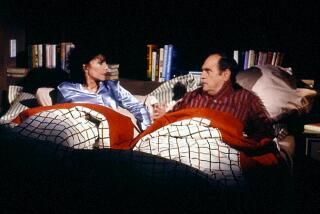Always room for laughs at the inn
- Share via
It was in the cafeteria of a Seattle Hilton that Bob Newhart got the inspiration for his second sitcom, the follow-up to “The Bob Newhart Show.” Hotel guests, he observed, are much like the patients of psychologist Robert Hartley on that 1970s small-screen classic -- not to be argued with, no matter how nonsensical.
As Newhart put it in a recent phone conversation, “I function well with a bunch of crazies around me that I can react to.”
Playing Dick Loudon, New York writer turned New England innkeeper, Newhart was once again the deadpan Everyman at the center of a gentle storm of character-based absurdity. “Newhart” hit the air in 1982 and took its famous final bow eight years later, with a crucial cameo by Suzanne Pleshette, the friend and former costar whom Newhart eulogized this year. Beginning with the 22 Season 1 episodes, the show made its DVD debut last week.
When you started doing sitcoms, you were already a huge comedy star. But even so, did anyone try to get you to put aside your low-key delivery, to play it bigger and broader?
No, they kind of knew what they were getting. On the first show, “The Bob Newhart Show,” we were shooting the pilot, and they said, “It’s running a little long. Could you run some of your sentences together?” I said, “This stammer got me a home in Beverly Hills and I’m not about to change it. So you’d better take out some words.” . . . I always felt that the best thing that a stand-up comic brought to a sitcom was not just the timing of the joke -- I mean, that’s important, how to deliver the joke -- but it was the integrity of the character. There would be times when I would say, “Guys, that’s a funny line, but I don’t think I would say that. Maybe give it to somebody else.”
With “The Bob Newhart Show,” you had created a tough act to follow. Did you have any trepidation about returning to series TV?
Yeah, I did. I worked with Barry Kemp, who was a writer on “Taxi,” on the creation of the pilot. I told him the idea about the hotel and he said, “What would you think about Vermont as the setting rather than Seattle?” And I said fine, because after you’ve done three or four rain jokes, you’ve kind of run out of material as far as Seattle is concerned. He took a trip to Vermont, and when he came back, he’d written a pilot and gave it to me. It was on my desk for about three days, and I kept circling it, as though it were radioactive -- because I was afraid it wasn’t going to be as good as “The Bob Newhart Show,” in which case I wouldn’t have gone back to television. But I read it and I loved it.
Season 1 of “Newhart” features characters who didn’t make it all the way through the show’s run. The essential chemistry is there, but it’s still a work in progress.
It was at a time when they would allow a show to grow and find its feet. In the first season, the big discovery, of course, was Larry, Darryl and Darryl [a strange fraternal trio who weren’t meant as series regulars until the studio audience’s enthusiastic response]. . . . This is one of the advantages of doing a show in front of a live audience, because you get that immediate feedback. Fewer and fewer shows are being done in front of a live audience, which I think is a shame. Because it really leads to better writing, and it leads to better performances. . . . Larry, Darryl and Darryl became cult figures after a while. I always felt they were right out of “Deliverance.” What they were doing in Vermont, I don’t know.
-- Sheri Linden


